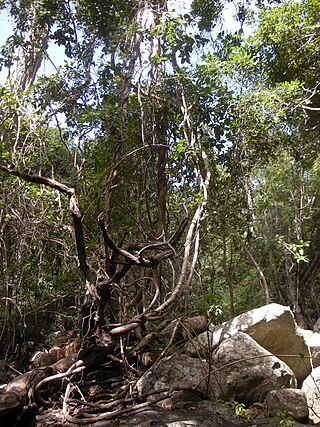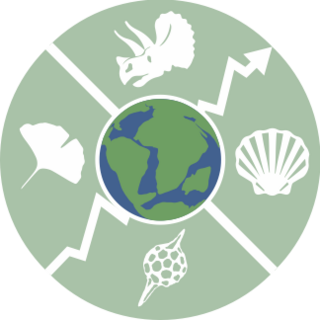Research
In 2010, Muller-Landau published a mathematical model of seed sizes, demonstrating that large seeds are favorable in stressful conditions while small seeds may be advantageous in more favorable conditions. [4]
Helene Muller-Landau is a staff scientist at the Smithsonian Institution. [1] Her research focuses on tropical forest diversity and climate interactions with tropical forests.
Helene Muller-Landau received her bachelor's from the Swarthmore College in Mathematics and Statistics. [2] [1] She received both her masters and PhD in Ecology and Evolutionary Biology from Princeton University. [1]
Muller-Landau received the Packer Fellowship for Science and Engineering in 2007. [3]
In 2010, Muller-Landau published a mathematical model of seed sizes, demonstrating that large seeds are favorable in stressful conditions while small seeds may be advantageous in more favorable conditions. [4]

Thomas Eugene Lovejoy III was an American ecologist who was President of the Amazon Biodiversity Center, a Senior Fellow at the United Nations Foundation and a university professor in the Environmental Science and Policy department at George Mason University. Lovejoy was the World Bank's chief biodiversity advisor and the lead specialist for environment for Latin America and the Caribbean as well as senior advisor to the president of the United Nations Foundation. In 2008, he also was the first Biodiversity Chair of the H. John Heinz III Center for Science, Economics and the Environment to 2013. Previously he served as president of the Heinz Center since May 2002. Lovejoy introduced the term biological diversity to the scientific community in 1980. He was a past chair of the Scientific Technical Advisory Panel (STAP) for the Global Environment Facility (GEF), the multibillion-dollar funding mechanism for developing countries in support of their obligations under international environmental conventions.

Barro Colorado Island is located in the man-made Gatun Lake in the middle of the Panama Canal. The island was formed when the waters of the Chagres River were dammed to form the lake in 1913. When the waters rose, they covered a significant part of the existing tropical forest, but certain hilltops remained as islands in the middle of the lake. It has an area of 15.6 km2 (6.0 sq mi).

A liana is a long-stemmed woody vine that is rooted in the soil at ground level and uses trees, as well as other means of vertical support, to climb up to the canopy in search of direct sunlight. The word liana does not refer to a taxonomic grouping, but rather a habit of plant growth – much like tree or shrub. It comes from standard French liane, itself from an Antilles French dialect word meaning to sheave.

The sun bear is a species in the family Ursidae occurring in the tropical forests of Southeast Asia. It is the smallest bear species, standing nearly 70 cm (28 in) at the shoulder and weighing 25–65 kg (55–143 lb). It is stockily built, with large paws, strongly curved claws, small, rounded ears and a short snout. The fur is generally short and jet black, but can vary from grey to red. The sun bear gets its name from its characteristic orange to cream-coloured chest patch. Its unique morphology—inward-turned front feet, flattened chest, powerful forelimbs with large claws—suggests adaptations for climbing.

The 1958 Atlantic hurricane season included every tropical cyclone either affecting or threatening land. There were ten named storms as well as one pre-season tropical storm. Seven of the storms became hurricanes, including five that were major hurricanes, or the equivalent of a Category 3 on the Saffir-Simpson scale. The strongest storm was Hurricane Helene, which became a strong Category 4 hurricane with 150 mph (240 km/h) winds and a barometric pressure of 930 millibars (27 inHg) while just offshore the southeastern United States.

Capsicum annuum var. glabriusculum, a chili-pepper variety of Capsicum annuum, is native to southern North America and northern South America. Common names include chiltepín, Indian pepper, grove pepper, chiltepe, and chile tepín, as well as turkey, bird’s eye, or simply bird peppers. Tepín is derived from a Nahuatl word meaning "flea". This variety is the most likely progenitor of the domesticated C. annuum var. annuum. Another similar-sized pepper, 'Pequin' is often confused with tepin, although the tepin fruit is round to oval where as the pequin's fruit is oval with a point, and the leaves, stems and plant structures are very different on each plant.

The Smithsonian Tropical Research Institute is located in Panama and is the only bureau of the Smithsonian Institution based outside of the United States. It is dedicated to understanding the past, present, and future of tropical ecosystems and their relevance to human welfare. STRI grew out of a small field station established in 1923 on Barro Colorado Island in the Panama Canal Zone to become one of the world's leading tropical research organizations. STRI's facilities provide for long-term ecological studies in the tropics and are used by some 1,200 visiting scientists from academic and research institutions around the world every year.

The Smithsonian Conservation Biology Institute (SCBI) is a unit of the Smithsonian Institution located on a 3,200-acre (13 km2) campus located just outside the town of Front Royal, Virginia. An extension of the National Zoo in Washington, D.C., the SCBI has played a leading role in the fields of veterinary medicine, reproductive physiology and conservation biology since its founding in 1974.

Seed predation, often referred to as granivory, is a type of plant-animal interaction in which granivores feed on the seeds of plants as a main or exclusive food source, in many cases leaving the seeds damaged and not viable. Granivores are found across many families of vertebrates as well as invertebrates ; thus, seed predation occurs in virtually all terrestrial ecosystems.

Susan Landau is an American mathematician, engineer, cybersecurity policy expert, and Bridge Professor in Cybersecurity and Policy at the Fletcher School of Law and Diplomacy at Tufts University. She previously worked as a Senior Staff Privacy Analyst at Google. She was a Guggenheim Fellow and a visiting scholar at the Computer Science Department, Harvard University in 2012.

Gustavia superba is an understory tree that grows in Central and north-western South America. Common names include membrillo, sachamango and heaven lotus. The trunk is around 5-10m high with the leaves radiating from the top.
Dolores Rita Piperno is an American archaeologist specializing in archaeobotany. She is a senior scientist emeritus of the Smithsonian Tropical Research Institute in Balboa, Panama and the Smithsonian National Museum of Natural History, Washington.

Cristián Samper is a Colombian-American tropical biologist specializing in conservation biology and environmental policy. He is the Managing Director and Leader of Nature Solutions at the Bezos Earth Fund. He served as President and CEO of WCS from 2012 to 2022. He was the Director of the Smithsonian Institution's National Museum of Natural History, the world's largest natural history collection, from 2003 to 2012, and served as acting Secretary of the Smithsonian from 2007 to 2008, the first Latin American to hold the position. In April 2015, Samper was inducted into the American Academy of Arts and Sciences.
The Ngel Nyaki Forest Reserve, whose site is historically known as Majang, is situated on the Mambilla Plateau in North East Nigeria, covering 46 km2. It can be reached on foot from Yelwa village past the Mayo Jigawal, from where it is less than half an hour’s walk to the upper edge of the forest. The elevation ranges from 1,400 metres (4,593 ft) to 1,600 metres (5,249 ft). Ngel Nyaki was formally gazetted a local authority Forest Reserve under Gashaka - Mambilla Native Authority Forest order of April 1969, but presently it is under the management of the Taraba State Government and the Nigerian Conservation Foundation (NCF), with the Nigerian Montane Forest Project (NMFP) as a project partner.

The Paleobiology Database is an online resource for information on the distribution and classification of fossil animals, plants, and microorganisms.
Hélène Menexia Massam was a statistician known for her research on the Wishart distribution and on graphical models. She was a professor of mathematics and statistics at York University in Canada.
Beryl B. Simpson is a professor emerita in the Department of Integrative Biology at the University of Texas at Austin. Previously she was an associate curator at the Smithsonian National Museum of Natural History in the Department of Botany. She studies plant systematics and tropical botany, focusing on angiosperms found in the American Southwest, Mexico, and Central and South America. She was awarded the José Cuatrecasas Medal for Excellence in Tropical Botany for her decades of work on the subject.
Egbert Giles Leigh, Jr. is an evolutionary ecologist who spends much of his time studying tropical ecosystems. He is a researcher for the Smithsonian Tropical Research Institute and is well known for the work he has done on Barro Colorado Island. He is a US citizen, but has resided at the Smithsonian in Panama for nearly 50 years. Along with studies on Barro Colorado Island, Leigh is also known for the research he has done related to the Isthmus of Panama and its historical significance on the evolution of South American species.

Wandering Rocks is a 1967 steel sculpture by Tony Smith, made in an edition of five plus one artist's proof. The Minimalist work comprises five different polyhedral elements painted black.
Noris Salazar Allen is a bryologist from Panama, who is Professor of Botany at the University of Panama and an associate researcher at the Smithsonian Tropical Research Institute. Salazar Allen was the first Panamanian to research bryophytes, and was instrumental in expanding the University of Panama's bryological collection to 10,000 specimens. In 2013 she received the Riclef Grolle Award for Excellence in Bryodiversity Research from the International Association of Bryologists.